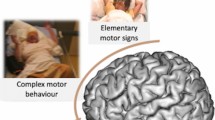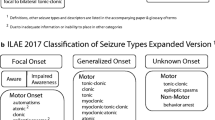Summary
Two mechanisms are discussed which link extracellular potassium accumulation and epileptogenic neuronal hyperactivity in the cortex. The potassium concentration (aK) of the environment of a repetitively discharging membrane can increase sufficiently for a supra-threshold depolarization at afferent terminals. This can explain the finding of ectopic spike generation and the antidromic breakthrough in thalamo-cortical projections after a primary cortical discharge. Spread and recurrent enhancement of excitatory drives may be the result of this mechanism. Initiation and termination of seizure is not explained by potassium accumulation. There is a ceiling level in potassium of about 10 mequ/1 which is strictly maintained during normal as well as epileptiform activity. This level is probably not high enough for depolarizing inactivation of neuronal membranes.
Stimulation of cortical afferents can have a dual effect on aK. After a primary shortlasting increase, aK can reach subnormal values. This is possibly brought about by a stimulated re-uptake of K+. Seizures can be initiated at these subnormal levels. The effect of the re-uptake e. g. hyperpolarization of terminal afferents and increase of evoked transmitter release is discussed for the initiation of paroxysmal activity.
Zusammenfassung
Zwei Wirkungszusammenhänge werden behandelt, die Kaliumakkumulation und epileptogene neuronale Hyperaktivität verbinden. Die K-Konzentration (aK) an einer repetitiv entladenden Membran kann genügen, um diese beträchtlich zu depolarisieren und Erregungen von afferenten Fasern und Synapsen hervorzurufen. K-Akkumulation kann ektopischen Erregungsvorgängen (Gutnick & Prince, 1972) und einem antidromen Erregungseinbruch in thalamo-cortikale Afferenzen nach einer vorausgehenden cortikalen Entladung zugrunde liegen. Krampfausbreitung und Verstärkung läßt sich durch einen rekurrenten Erregungszustrom erklären. Im erregbaren Cortex ist ein maximales aK von 10 mequ/1 zu finden, das auch während epileptiformer Aktivität nicht überschritten wird. Dieser Kaliumspiegel ist nicht ausreichend, neuronale depolarisierende Inaktivierung und demnach das Erampfende einzuleiten.
Erregung cortikaler afferenter Fasern kann duale Wirkung auf aK zeigen. Es werden durch Erregung häufig subnormale Werte des extrazellulären aK gefunden, die möglicherweise durch eine aktivierte Reabsorption von Kalium hervorgerufen werden. Epileptiforme Entladungen können durchaus auch bei subnormalem aK beginnen. Mögliche Effekte der K-Reabsorption, z. B. eine Hyperpolarisation terminaler Afferenzen und Anstieg evozierter Transmitterfreisetzung werden diskutiert im Hinblick auf den Befund initial verstärkter synaptischer Erregungsvorgänge während paroxysmaler neuronaler Entladungstätigkeit.
Similar content being viewed by others
Literatur
Bignami, A., Palladini, C.: Experimentally produced cerebral status spongiosus and continuous pseudorhythmic EEG discharges with a membrane ATPase inhibitor in the rat. Nature 109, 413–414 (1966)
Brinley Jr., F. J., Kandel, E. R., Marshal, W. H.: Potassium outflux from rabbit cortex during spreading depression. J. Neurophysiol. 23, 246–256 (1960)
Coombs, J. S., Eccles, J. C., Fatt, P.: The specific ionic conductances and ionic movements across the motoneuronal membrane that produces the inhibitory post-synaptic potential. J. Physiol. (Lond.) 130, 326–373 (1955)
Creutzfeldt, O. D., Watanabe, S., Lux, H. D.: Relations between EEG phenomena and potentials of single cortical cells. I. Evoked responses after thalamic and epicortical stimulation. Electroenceph. clin. Neurophysiol. 20, 1–18 (1966)
Del Castillo, J., Katz, B.: Quantal components of the end-plate potential. J. Physiol. (Lond.) 124, 560–573 (1954)
Fatt, P., Katz, B.: The analysis of the end-plate potential recorded with an intracellular electrode. J. Physiol. (Lond.) 115, 320–370 (1951)
Fertziger, A. P., Ranck, J. B., Jr.: Potassium accumulation in interstitial space during epileptiform seizures. Exp. Neurol. 26, 571–585 (1970)
Gutnick, M. J., Heinemann, U., Lux, H. D.: Intra-thalamic neuronal activity and changes in [K+]o during cortical seizure. (In prep.)
Gutnick, M. J., Prince, D. A.: Thalamocortical relay neurons: Antidromic invasion of spikes from a cortical epileptogenic focus. Science 176, 424–425 (1972)
Hagiwara, S., Tasaki, I.: A study of the mechanism of impulse transmission across the giant synapse of the squid. J. Physiol. (Lond.) 143, 114–137 (1958)
Harreveld van, A.: Brain Tissue Electrolytes. Washington D. C.: Butterworths (1966)
Harreveld van, A., Cromwell, J., Malhotra, S. K.: A study of extracellular space in central neurons tissue by freeze-substitution. J. Cell. Biol. 25, 117–137 (1965)
Heinemann, U., Lux, H. D.: Intra-thalamic neuronal activity and changes in [K+]o during cortical seizure. (In prep.)
Hodgkin, A. L., Huxley, A.F.: Currents carried by sodium and potassium ions through the membrane of the giant axon of Loligo. J. Physiol. (Lond.) 116, 449–472 (1952)
Ito, M., Oshima, T.: The extrusion of sodium from cat spinal motoneurons. Proc. Roy. Soc. B, 161, 109–131 (1964)
Jung, R., Tönnies, J. F.: Hirnelektrische Untersuchungen über Entstehung und Erhaltung von Krampfentladungen: Die Vorgänge am Reizort und die Bremsfähigkeit des Gehirns. Arch. Psychiat. Nervenkr. 185, 701–735 (1950)
Kerkut, G. A., Thomas, R.: An electrogenic sodium pump in snail nerve cells. Comp. Biochem. Physiol. 14, 167–183 (1965)
Kuffler, S. W., Potter, D. O.: Glia in the leech central nervous system: Physiological properties and neuron-glia relationship. J. Neurophysiol. 27, 290–320 (1964)
Liley, A. W.: The effects of presynaptic polarization on the spontaneous activity at the mammalian neuromuscular junction. J. Physiol. (Lond.) 134, 427–443 (1956)
Llinás, R.: A possible mechanism for presynaptic inhibition. In: Structure and Function of Inhibitory Neuronal Mechanisms. Ed. von Euler, C., Skoglund, B., Söderberg, U.; pp. 249–250, London: Pergamon Press (1968)
Lux, H. D.: Ammonium and chloride extrusion: Hyperpolarizing synaptic inhibition in spinal motoneurons. Science 173, 555–557 (1971)
Lux, H. D.: The kinetics of extracellular potassium: Relation to epileptogenesis. Epilepsia 15, 375–393 (1974)
Lux, H. D., Loracher, C., Neher, E.: The action of ammonium on postsynaptic inhibition of cat spinal motoneurons. Exp. Brain Res. 11, 431–447 (1970)
Lux, H. D., Neher, E.: The equilibration time course of [K+]o in cat cortex. Exp. Brain Res. 17, 190–205 (1973)
Lux, H. D., Singer, W.: Changes of extracellular potassium concentration in cat visual cortex after stimulation of specific and unspecific afferents. Pflügers Arch. Suppl. 343, R137 (1973)
Matsumoto, H., Ajmone-Marsan, C.: Cortical cellular phenomena in experimental epilepsy, interictal manifestations. Exp. Neurol. 9, 286–304 (1964)
Moody Jr., W. J., Futamachi, K. J., Prince, D. A.: Extracellular potassium activity during epileptogenesis. Exp. Neurol. 42, 248–263 (1974)
Neher, E., Lux, H. D.: Rapid changes of potassium concentration at the outer surface of exposed neurons during membrane current flow, J. Gen. Physiol. 61, 385–399 (1973)
Pedley, T. A., Zuckermann, E.C., Glaser, G. H.: Epileptogenic effects of localized ventricular perfusion of ouabain on dorsal hippocampus. Exp. Neurol. 25, 207–219 (1969)
Prince, D. A.: Cortical cellular activities during cyclically occurring interictal epileptiform discharges. Electroenceph. clin. Neurophysiol. 31, 469–484 (1971)
Prince, D. A., Lux, H. D., Neher, E.: Measurement of extracellular potassium activity in cat cortex. Brain Res. 50, 489–495 (1973)
Rang, H. P., Ritchie, J. M.: On the electrogenic sodium pump in mammalian non-myelinated nerve fibres and its activation by various external cations. J. Physiol. (Lond.) 196, 183–221 (1968)
Ritchie, J. M., Straub, R. W.: The hyperpolarization which follows activity in mammalian non-medullated fibres. J. Physiol. 136, 80–97 (1957)
Tower, D. B.: Neurochemistry of Epilepsy. Springfield, Ill. 1960
Vyskocil, F., Kriz, N., Bures, J.: Potassium-selective microelectrodes used for measuring the extracellular brain potassium during spreading depression and anoxic depolarization in rats. Brain Res. 39, 255–259 (1972)
Walker, J. L., Jr.: Ion specific liquid ion exchanger microelectrodes. Anal. Chem. 43, 89A-93A (1971)
Zander, K., Heinemann, U., Lux, H. D.: Effects of norepinephrine, DB-c-AMP and theophyline on the extracellular potassium activity in the visual cortex of the cat. Pflügers Arch. Suppl. 359, R87 (1975)
Zuckermann, E. C., Glaser, G. H.: Arch. Neurol. (Chic.) 23, 358 (1970)
Author information
Authors and Affiliations
Additional information
Herrn Professor Dr. med. Gerd Peters zu seinem 70. Geburtstag gewidmet.
Rights and permissions
About this article
Cite this article
Lux, H.D. Kaliumaktivität im Cortex der Katze: Untersuchungen zur experimentellen Epilepsie. Arch. F. Psychiatr. U. Z. Neur. 221, 227–244 (1976). https://doi.org/10.1007/BF00418482
Received:
Issue Date:
DOI: https://doi.org/10.1007/BF00418482




